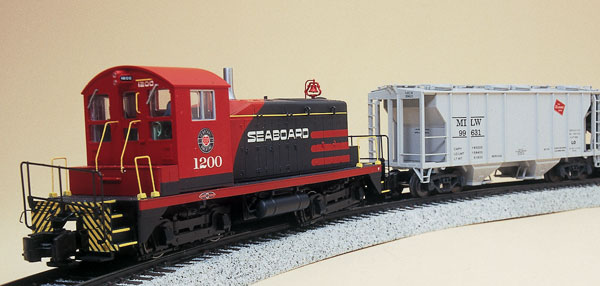By any criterion, the Electro-Motive SW1 diesel switcher was a milestone locomotive. The humble engine was a real pioneer of the diesel era. More than 560 were sold between 1939 and 1953. These engines were the first taste of internal combustion power that many railroads and industrial firms experienced, and they helped push steam power to the scrapyard.
The 600-horsepower locomotive featured the Electro-Motive 6-cylinder 567 diesel engine, which was the starting point for 12- and 16-cylinder prime movers used in later freight and passenger hauling engines. This was one useful locomotive design.
The engine’s tooling reflects the many delicate details that we’ve come to expect from S-Helper. Details, I might add, that unlike HO or N scale engines, you don’t need a magnifying glass to see and appreciate.
Hatches, hinges, and texture call for you to reach out and touch the body. The cab is fully decked out with a two-man crew. The engine has a tall exhaust stack (indicative of a later production model) as well as windows that follow the arch of the cab roof.
The engine also has metal hand grabs and a neat looking expansive deck – the by-product of the prototype using a relatively small diesel engine. The front and rear sandboxes would look great with a few S gauge brakemen sitting atop them, planning the next big move in the freight yard.
All S-Helper diesels come with your choice of end railings, so you can use single-unit or multiple-unit connections to suit your taste. If you are swayed by the dark side of the force, the engines also include scale wheels and a converter for DC power operation.
I’ve said it before: S-Helper’s trains offer some of the finest decoration in the industry and the SW1 is no exception. Engine decoration was excellent on the three engines we examined. Paint application was neat and clean, and all lettering and other applied decoration was crisp. Especially of note was how much pizzazz S-Helper injected into two basically dull paint schemes: the Boston & Maine and the Seaboard. The B&M’s shield and the Seaboard’s red stripes are quite eye-catching, not bad for two engines wearing basic black.
The SW1 is offered in Boston & Maine, Chessie System (C&O), Chicago & North Western, Lehigh Valley, Milwaukee Road, Pennsylvania, Seaboard, Soo Line, and Western Pacific road names. All units except Seaboard and Soo are available in two road numbers.
It was a pleasure to operate this engine, which easily managed a 10-car train consisting of postwar and modern Flyer cars as well as rolling stock by American Models and S-Helper.
Beginning with the SW1, we’ll be comparing the performance of new engines with that of older, benchmark locomotives. In the case of S gauge diesels, the benchmark will be an American Flyer Geep, while the steam benchmark for S gauge will be a Flyer 4-6-4.
The 1 pound, 3 ounce SW1’s performance was comparable to S-Helper’s SW7 (CTT, September 1998) but better than our benchmark Flyer Geep. Using an MTH Z-4000 transformer, average speed was 20.3 scale mph on the low end and 76.2 scale mph on the high end. Drawbar pull was 4.3 ounces, which roughly equals 30 modern, free-rolling freight cars on straight and level track. In all speed ranges the amperage draw was virtually unmeasurable.
S-Helper Service has done the S gauge community another good turn by releasing a unique looking locomotive with the smooth running characteristics of its earlier release, the SW7. If you are interested in new S gauge switching power, run, don’t walk, down to your S gauge retailer to check out S-Helper’s SW1. You won’t be disappointed!














